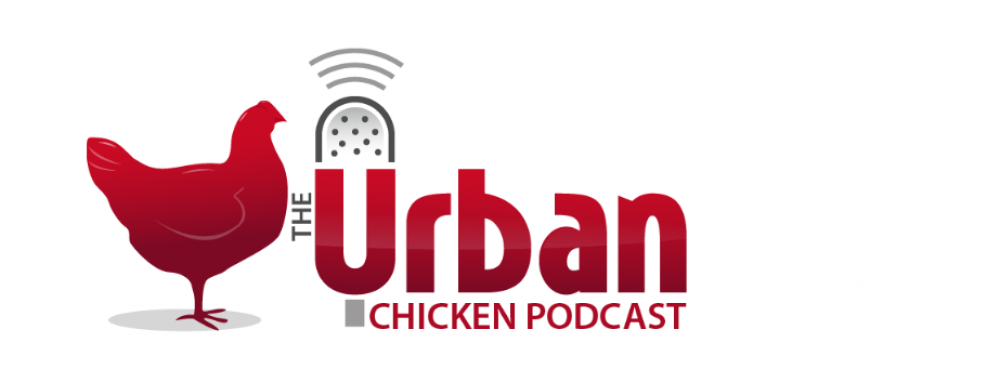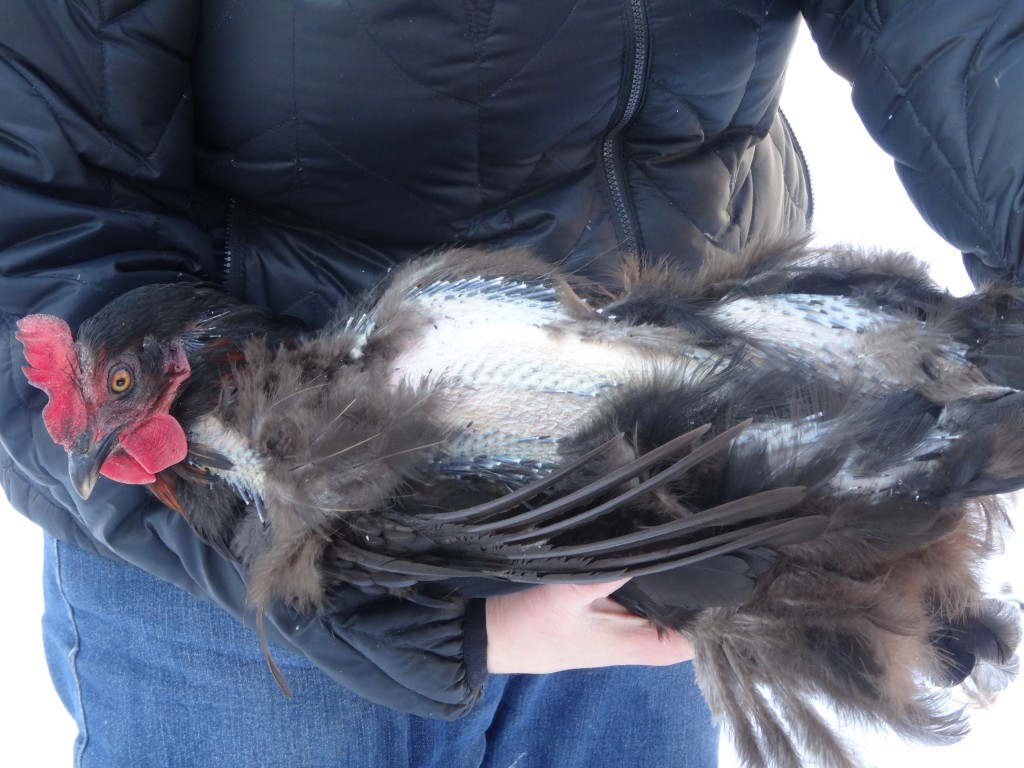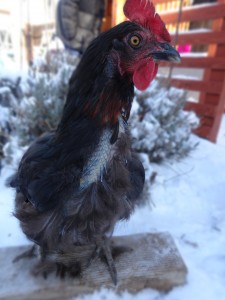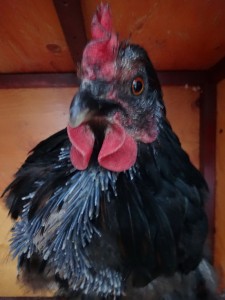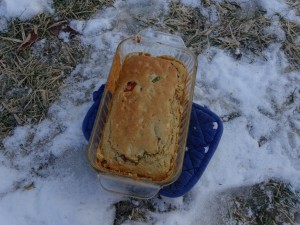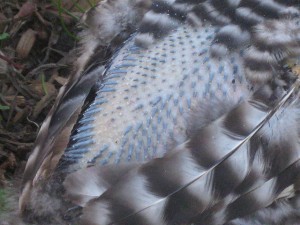Frida Chicken turned up in the coop mostly naked and looking quite chilled a couple weeks ago – just before Christmas. Wintertime in Boise, Idaho is cold and snowy, with the days hanging at or below freezing. This is a particularly inopportune time for a chicken to decide to chuck her feathers in a massive molt. Today on the Urban Chicken Podcast, we take a close look at the molting process and consider such questions as what causes it and how to help your hens through it with as much ease as possible. Molting is a natural and necessary process by which chickens lose old, broken, worn out and soiled feathers for new plumage on a regular basis. It is important that a chicken grow new feathers from time to time because the integrity of a bird’s feathers affects how well that bird is able to keep itself warm in cold weather. An unsuspecting newbie chicken owner can become quite alarmed by the molting cycle – especially if his/her chicken molts in an unexpected manner.
Chickens will go through several molts during their lives. If you have raised chickens up from chicks, then you have already experienced a couple chicken molts. Chickens have juvenile molts as they are getting in their first feathers. The first juvenile molt begins when the chick is only 6-8 days old. This first juvenile molt is when the chick loses its downy covering and grows its first feathers. It takes about four weeks for the bird to fully replace all of its down with feathers.
The second juvenile molt occurs when the bird is about 8-12 weeks old. This molt is when the bird’s first feathers are replaced with its second set of feathers. It is during this second juvenile molting process that male chicken’s ornamental feathers grown in (e.g. long sickle tail feathers, long saddle feathers, etc.). It is with this second juvenile molt that some backyard chicken keepers make the disappointing discovery that the “sexed” chick they bought was sexed wrong and they have a rooster on their hands that they cannot keep.
Chickens typically go through their first adult molting when they are about 18 months old. On average, adult molting occurs in the late summer or fall and the chicken will grow in its replacement feathers fully within 8-12 weeks. Not all birds conduct their molts in the conventional manner – some chickens will drag out the process for up to 6 months.
My silly black Sex-link hen, Frida, has chosen to eschew “normal” molting habits for her own style. She began her first adult molt this past May when she lost the feathers on both sides of her torso. It was not evident that she was losing feathers until you picked her up and touched the nude portions of her skin tucked up under her wings. Despite this bald spot, Frida did not grow in any pin feathers. She simply kept these two nude patches for months while continuing to lay on a regular schedule. Frida maintained in this manner until mid-December when she suddenly began to molt hard.
There are two different styles of molting – soft and hard. A soft molt is when the bird loses some feathers but the effect is such that the untrained eye might not even realize that the chicken is losing and replacing feathers. The other style, a hard molt, is marked by the bird suddenly and dramatically losing a vast quantity of feathers giving it a nude appearance.
Feathers are comprised of 80-85% protein. A molting chicken’s body simply cannot support both feather and egg production simultaneously. Consequently, molting causes either a significant reduction in egg productivity or, more commonly, a full hiatus from egg-laying until the hen’s new feathers are in fully.
Chicken owners can help their molting chickens through this process by providing more protein to their flock. Typical layers feed is 16% protein – during a molt, consider switching to a broiler blend of feed which will be 20-25% protein instead. I really like the Organic, Soy-free, broiler mix from Scratch and Peck Feeds. It is high quality feed that you can actually have delivered to your front door through Amazon. Convenient! If you have an Amazon Prime membership, the 25 lb bags of Scratch and Peck Feed would be delivered free.
Additionally, I have supplemented Frida’s protein intake by preparing special treats
that are protein rich. Lately, I have been baking my birds a homemade cornbread that is supplemented with nuts, flaxseeds and dried fruit and made with yougurt in the batter. The added nuts, flaxseeds and yogurt boost this snack’s protein levels to help Frida get her feathers back in quickly. Other chicken keepers often supplement their molting birds’ diets with protein rich snacks, such as: sunflower seeds (raw – unsalted), peas, soybeans, meat (tuna fish); cod liver oil, bone meal, or even cat food to help with feather production.
There are different triggers for a molt. The usual cause of molting is a decrease of daylight hours and the end of an egg-laying cycle – which typically coincide with late summer or early fall. However there are several less innocuous causes of molting as well. Physical stress, a lack of water, malnutrition, extreme heat, the hatching of a clutch of eggs, and unusual lighting conditions can all be at the root of an unexpected or untimely molting as well. In Frida’s case, I do not believe that one of the more troubling causes of molting is at the root of her wintertime nudity. Rather, I think that her body was simply confused. This is her first adult molt and she began it in a timely fashion but stalled out – presumably because she did not stop laying regularly. The shorter day light hours and extremely cold may have kicked the interrupted molt back into action.
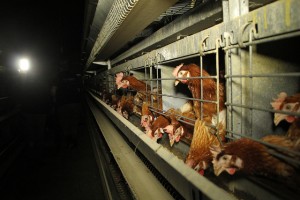 In commercial egg-laying factory farms, it is common to force a molt of its flock. Forced molting is a method by which the farm forces all of the birds to molt at the same time in the interest of efficiency and enhanced egg-laying. In order to force a unified molt, the farm withholds any feed from the birds for 7-14 days to stress their bodies into molting. It is a cruel practice that is already outlawed in the United Kingdom.
In commercial egg-laying factory farms, it is common to force a molt of its flock. Forced molting is a method by which the farm forces all of the birds to molt at the same time in the interest of efficiency and enhanced egg-laying. In order to force a unified molt, the farm withholds any feed from the birds for 7-14 days to stress their bodies into molting. It is a cruel practice that is already outlawed in the United Kingdom.
Lastly, pin feathers are quite uncomfortable for the molting bird. It is important to be mindful of this fact, and limit the handling of your molting chickens until their feather are properly restored.
CHICKEN NEWS:
- Express – Phantom of the Opera is Helping Lay Eggs ARTICLE
- Mail Online – Music helps Chickens Lay Better ARTICLE
MAIN SEGMENT:
- AMAZON -Scratch and Peck Feed – Organic, Soy Free Broiler Chicken Feed, 25lb
- Grit – “Molting: What it is & How to Help Chickens Get Through It” ARTICLE
- HenCam – The Molt ARTICLE
- BYC Forum – Thread on Molting FORUM
- My Pet Chicken – What is Molting? LINK
- Wikipedia – Forced Molting LINK
- Fowl Visions – Molting (reader comments regarding heat and molting) LINK
- Fresh Eggs Daily – Molting Meatloaf RECIPE
- The Chicken Chick – Muffins for Molting RECIPE
Podcast: Play in new window | Download | Embed
Subscribe: Apple Podcasts | RSS
